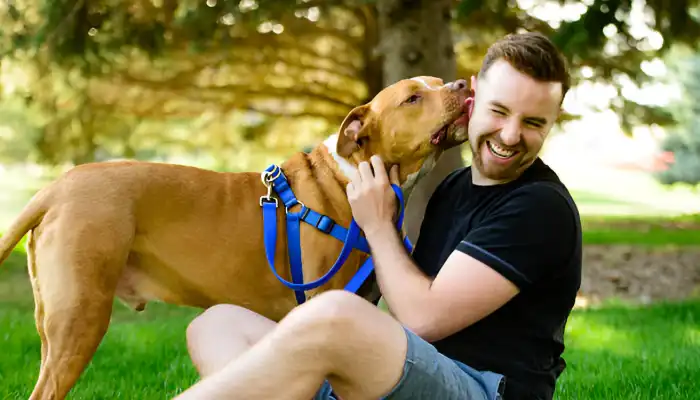How to Speak Dog Language Translator – Most of the pet owners find it quite interesting to think about the understanding of dogs beyond barks and tail wags. Whether you are trying to understand your dog’s needs, emotions, or even playful actions, the interaction with the companion is more than just basic commands.
Here, the basics will be discussed concerning how dog sound translator devices are revolutionizing the way people relate with their pets and “How to Speak Dog Language Translator” with or without the aid of technology. Together, let’s explore better ways of communicating with man’s best friend and uncover the wonders of dog language.

How to Speak Dog Language Translator? – An Overview
Dogs are some of the most expressive animals that there are, although they have a very different way of communicating compared to humans. Being able to comprehend their ‘language’ can enhance the relationship that you have with your pet and make training, behavior, and intimacy more effective. Many dog owners tend to ask, “How to Speak Dog Language Translator?” – is there really a gadget that can translate a dog’s barks and movements into human speech?
Even with the advancement of technology and tools like dog bark translator, the most effective way to communicate with dogs is still to understand natural signals. This guide will help you grasp some of the fundamentals that pertain to dog language so that you are able to better communicate with your pet.
Basics of Dog Language
While dogs cannot communicate verbally, they do possess their own methods of expressing feelings and intent. This includes vocalizing, moving their bodies, and showcasing certain facial expressions. They translate emotions into barks, tail wags, and even their posture. If you are curious about how to talk to your pets, you need to learn how tell the signs. So if you are looking for an answer to the question, “How to Speak Dog Language Translator”, you need to get familiar with talking your dog first.
What are the Forms of Dog Communication?
Dogs are capable of expressing themselves through sound, body movements, and expression. Here are some of the prominent methods of their communication.
1. Vocal Expressions (Barking, Whining, Growling)
- Barking – To show excitement, give a warning or to make a request.
- Whining – A sign of nervousness, surrendering, or need for attention.
- Growling – A way to show aggression, discomfort, or playfulness.
- Howling – To speak and make oneself heard over a distance or as a reaction to certain sound.
- Sighing, Huffing – The act of portraying boredom, mild annoyance, or relaxation.
2. Body Movements and Postures
A dog’s body posture can tell a lot about its mood and intentions. Here’s a quick reference table:
| Body Language | Meaning |
|---|---|
| Relaxed, loose body | Comfort, contentment, or friendliness |
| Tail wagging slowly | Uncertainty, curiosity, or mild stress |
| Tail held high, stiff | Confidence or potential aggression |
| Tucked tail | Fear, submission, or anxiety |
| Ears perked forward | Alert, curious, or engaged |
| Ears flattened back | Fear, submission, or stress |
| Rolling onto back | Submission or asking for belly rubs |
| Play bow (front down, rear up) | Invitation to play |
3. Facial Expressions
- Relaxed, open mouth – Satisfied and comfortable.
- Licking lips (without food present) – Unsure, mixed emotions, or to self soothe.
- Yawning (when not sleepy) – Easing anxiety or agitation.
- Wide eyes, whale eye (showing white of eyes) – Distress or anxiety.
Typical Actions By A Dog And Their Interpretation
Even though some actions might seem odd to us, these typical actions made by dogs have different meanings:
- Circles before sitting down – An instinctive behavior meant to make a cozy sleeping area.
- Head Tilt – A demonstration of concentration in sounds or sights.
- Pawing you – Showing affection, getting attention, or reaching out.
- Zoomies – Hart racing outburst motivated by excitement or anxiety.
- Sniffing another dog’s rear – A form of greeting and identification in dogs.
To answer the question of why understanding dog language is important is simple – recognizing these signals has a huge impact on the relationship you have with your pet. It improves the bond you share, reduces potential behavioral misunderstandings, as well as issues. From training to simple social bonding, reading signals is a core part of communication between you and your dog.
So next time you find yourself pondering, “How to Talk Dog Translator?”, remember that it really is as simple as observing and understanding your dog.

Understanding Dog Barks and Other Sounds
It is a known fact that barking, growling, howling, and whining is a dog’s main mode of communication, but each of these vocal expressions have different meanings based on tone, pitch, and context. Understanding these expressions is crucial if you want to fully understand your dog. If you’ve ever wondered, “How to Speak Dog Language Translator?“, this section will help you break down your dog’s vocal expressions.
Different Dog Barks and What They Mean
Dogs have been known to bark for different reasons such as to communicate with their owners, and each reason serves a different purpose. If you still have issues understanding the different noises made by dogs, the table below aims to assist you.
| Type of Bark | Meaning | Common Situations |
|---|---|---|
| Alert/Warning Bark | Your dog has noticed something different or suspicious. | Barking at strangers, intruding noises, or other unfamiliar happenings. |
| Playful Bark | Dog is satisfied and full of energy. | Playing dress up with other dogs or toys or greetings. |
| Anxious/Nervous Bark | Dog is confused or going through some trouble. | Feeling unfamiliar or in different surroundings. |
| Demand Bark | Seeking for attention or wanting something. | When the dog needs something like food, toys, or going for a walk. |
| Lonely/Separation Bark | The dog sounds sad due to being all by itself. | Occurs when the proprietor vacates the property for an extended duration. |
Explaining Growling, Whining, and Howling Dogs
Apart from barking, dogs make use of other vocal signals to express feelings and intentions.
1. Growling
Growling is commonly misperceived as a sign of aggression. Here are some ways how:
- Let Me Go Growl – Let me go is a sound made when someone provokes a dog more than what is acceptable.
- Back Off Growl – A dog is feeling threatened and would like something or someone to withdraw from their space.
- I Can’t Bear It Growl – Suggests a dog is hurt and is lying uncomfortably.
2. Whining
Whining is considered to be a more subtle form of vocal expression, but not limited to the following:
- Looking For Support – The dog is anxious for attention.
- Stressors – Scaring new places or unknown people.
- Enthusiasm – Some dogs begin to whine when they are extremely excited e.g., when meeting new people.
3. Howling
For several reasons, primarily the same as their ancestral wolf behavior, dogs do tend to howl.
- Howling Dogs – Some may begin howling when they hear a siren or are prodded by other loud sounds.
- Mock Loneliness – Sometimes, howling can signal banishment or masking companionship.
- Bitches coming in season – Some of these howl to declare the area which they claim as their territory.
How to Identify a Dog’s Mood Through Vocal Cues
It is common for dogs to combine vocal sounds with body language to ensure that their message is clear and the recipient understands them.
Dogs often combine vocal sounds with body language to convey their feelings. The table below explains what to look for:
| Vocalization | Body Language | Dog’s Likely Mood |
|---|---|---|
| Short, sharp barks | Relaxed body, wagging tail | Happy, playful |
| Deep, continuous barking | Stiff posture, alert ears | Defensive, warning |
| Low growl + baring teeth | Stiff stance, direct eye contact | Aggression, warning |
| Whining + lowered ears | Tail tucked, avoiding eye contact | Fear, submission |
| Excited howling | Jumping, wagging tail | Happy, playful |
| Prolonged howling | Restless pacing, staring into distance | Lonely, seeking company |
A critical step in How to Speak Dog Language Translator is understanding the meaning behind your dog’s barks, growls, whines, and howls. Your communication with your pet will certainly improve if you pay attention to tone, pitch, and the dog’s body language.
How to Speak “Dog” and Ensure Proper Communication
How to speak dog language translator is all about mastering and interpreting the vocal or body signs while effectively passing communication. Below are steps on how to interact with your dog.
1. Give Commands Repeatedly
Dogs learn through repetition. Use clear, short commands like:
| Command | Meaning | Example Usage |
|---|---|---|
| Sit | Sit down | Before meals or crossing roads |
| Stay | Remain still | Before opening doors |
| Come | Approach | Calling from a distance |
| Down | Lie down | Calming excitement |
Tip: Use a firm but calm voice to avoid confusion.
2. Pair Your Voice With Action
- Happy tone = Encouragement
- Calm tone = Commands
- Firm stance = Authority
- Relaxed posture = Trust
Do not shout and avoid sudden movements that may scare your dog.
3. Positive Reinforcement Method
Offer reward for good actions:
- Treats
- Praise (“Good boy!”)
- Affection (petting, belly rubs)
Tip: Instead of punishing mistakes, redirect behavior positively.
4. Learn Sign Language of the Dog
Body language plays an important role in dog communication:
- Wagging tail = Excitement (but stiff wag = alertness)
- Pinned ears = Fear or submission
- Eye contact = Trust (hard stare means that its a negative aggression)
- Posture = Your position and whether it is tense or comfortable.
Now you know how to read the expressions of the dog.
5. Strengthen your bond
- Daily walks and time to play
- Short training sessions
- Reciting words to them
Good relationships allow communication without effort.
how to speak dog language translator is more than simply understanding words; it involves employing a unique form of technology specific to a given dog. Stick to your rules, watch their body language, and act how they need you to—with love and gentleness.

Common Mistakes in Dog Communication
While communicating with a dog, particular mistakes can be detrimental for understanding interaction which needs to be avoided. This section outlines errors often made and suggests ways to fix them.
Inadequate Use of Nonverbal Communication
Dogs understand body language much more than words. Therefore, the motions alone without words will create a problem. While learning how to speak dog language translator, it is important to verbalize while signaling so that the dog understands what is being said.
Assuming All Tail Movements Depict Friendly Nature
Not all tail movements show that a dog is willing to be friendly. Tail movements in a stiff and low position can be show of hostility and discomfort rather than being happy. To best interpret the dogs feelings and emotions, watch the whole body posture closely.
Ignoring Signs of Stress
Pacing, whining and hiding at one particular spot are all signs of stress in a dog. Failing to understand these signals and the underlying issue would hamper communication. Grasping these signals will help foster a better relationship between you and your pet as you learn how to speak dog language translator.
Varying Commands
Giving different commands with different wording can lead the dog into confusion. Instead, the dog can be provided commands by which together speech is properly structured and body language understood.
Correcting these popular mistakes can enhance your communication skills with your dog. An assist can be offered by a dog language translator, but the most effective way to strengthen the bond and understanding between you is through observing your dog’s distinct behaviors.
Conclusion
To sum up, Although there are apps and devices like the How To Speak Dog Language Translator that make communicating with dogs easier, the best approach still involves close observation and interpretation of their non-verbal communication.
Identifying various barks, different body movements, and facial gestures can prove beneficial in enhancing the relationship you have with the pet. The How To Speak Dog Language Translator certainly has its benefits, but nothing can replace the understanding that comes with quality time spent together with your dog.
